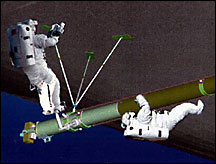 |

Finally, the Space Shuttle is returning to space!
Besides the international backgrounds of the Space Shuttle astronauts, the Space Shuttle program involves a lot of people from various countries. As a Japanese Astronaut myself, I am very proud that Japanese Astronaut Soichi Noguchi is taking a leading role in the extravehicular activities on the STS-114 mission.

My role for the Space Shuttle’s return to flight, as a representative of the NASA Astronaut Office, was to support the development of the OBSS (Orbiter Boom Sensor System). The OBSS is a boom-shaped system which was developed to inspect and repair damages on the Shuttle’s thermal protection system such as tiles on the orbiter bottom and the reinforced carbon-carbon panels on the wing leading edge.
Under the direction of the project manager, Kim Ess, various engineers gathered to work on the development of the OBSS. One of our essential roles as astronauts was to make recommendations from the point of view of an astronaut operating the OBSS in space to ensure operational safety and mission success. For instance, in order to avoid any structural contact between the OBSS and the Space Shuttle orbiter during OBSS operation, I supported the effort to determine the appropriate location of a new camera that would improve clearance monitoring during the OBSS operation. I also supported the effort to ensure that the OBSS trajectory and the rate of the OBSS motion would be acceptable for operational safety. My experience with the Space Shuttle’s robotics operation in satellite retrieval and the assembly of the International Space Station was very helpful in order to support the OBSS development, especially when we were discussing how the OBSS could be operated safely at night or with poor visibility of structural clearance.
|
 |
 |


The OBSS (Orbiter Boom Sensor System) is attached to the end of the robotic arm of the Space Shuttle. It is 50-foot-long. Two laser sensors and a camera are installed on the edge of the OBSS to inspect for any damage to the thermal protection system. The OBSS can cover areas which the original robotic arm cannot reach.(Courtesy of NASA)


The OBSS on the Space Shuttle Discovery is waiting for launch at the Kennedy Space Center.(Courtesy of NASA)


Astronauts are working on the OBSS. (illustration)(Courtesy of NASA)
|
 |
 |